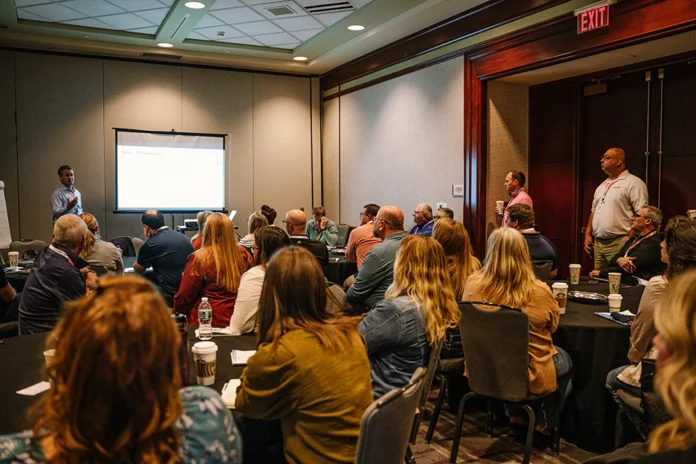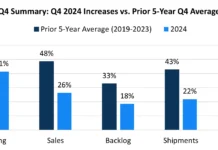
By Jim LeGacy, president and CEO, Orion Performance Compounds
As a commercial leader, I’ve been in a unique position, visiting hundreds of facilities and witnessing the companies that are doing everything correctly, and the companies that are not. In most cases, a lack of clear objectives and leader reinforcement is the downfall. This leads to lower productivity, low employee retention rates and departmental silos that keep cooperation at a minimum.
In my experience, when a company sets goals for its employees, the employees work hard to meet those goals. When these goals are met, the company can celebrate together and the employee feels invested in that achievement. Goal setting is an often forgotten and important retention tool. Employees are less likely to leave a company where they feel successful and celebrated. If goals are not set, reinforced, and measured, there’s nothing to recognize or celebrate.
There are key questions (talking points) that leaders can use to guide goal setting in each department throughout a company. The questions revolve around improving profitability; however, they also offer a way to measure progress and eventually success. There are tens of millions of dollars of productivity improvements available in US molding operations, but an organization must be hungry for change and have a plan. Organizational silos need to be eliminated. Nothing brings a team together like clear objectives and goals that can’t be achieved unless all departments work together.
In each department within a company, there are different styles of employees who are slowing organizational progress – or stopping it in its tracks. Who are these employees, and what questions can be asked to help them think differently?
Department: Sourcing
The goals of a successful sourcing department are to manage (more so) in an inflationary economy, to drive down costs to ensure profitability and to make sure the plant never runs out of material. The purchasing team also is responsible for building supplier relationships. – Suppliers are an often-underutilized source of leads for new business growth. In many cases, the sourcing people who are the face of an organization aren’t building relationships with new suppliers. When this happens those leads are going to someone else – likely, a competitor.
Three types of employees who slow progress:
Mr. Favorite: He has his favorite suppliers, and he’s not interested in listening to others. He won’t return calls even if someone is offering shorter lead times or better pricing. What is he missing?
Ms. Surface Skimmer: She’s placing orders but lacks resin knowledge depth and doesn’t understand deep competitive advantages. She’s paying higher prices than necessary.
Mr. Comfortable: He doesn’t like change as it creates work. He’s losing money for the company because he won’t rock the boat.
Questions to ask:
What is your cost-out goals for this quarter and next?
What can the sourcing department teach others in the company about the players in the particular resin markets?
How many parts rely on single-sourced materials?
What is been done creatively to save the company money? Consignment, alternate supplier, negotiations?
Department: Human Resources
Many people believe the human resources role is only focused on benefits administration, managing hourly wages and union negotiations. HR should be the conduit for bringing people together, framing and documenting the goals for the year, and creating a dashboard. When HR sets goals for employees and puts them in writing, it makes it easier to respond when John Q. employee comes in asking for a raise. For example, if a company wants to grow profits by 7%, all employees should know what their role is in that process – and their goals should be measured.
Three types of employees who slow progress:
Mr. Ivory Tower: He thinks HR is a benefits administration position, not a job focused on people.
Ms. Politics: Enough said…
Ms. Plant-Focused: She spends 90% of her energy on the plant and needs more time with management staff to set clear individual and team goals.
Questions to ask:
What is the succession plan for key roles?
What is the company doing to hold onto top talent?
What are the development goals for executive staff – both individually and as a team?
What strategies will be used to attract top talent this quarter?
What personality characteristics are being targeted during the recruiting process? Be specific.
Department: Engineering
The engineering group often sees every issue as black and white – engineers are responsible for design, but not costs. However, nothing new or innovative can be implemented without an engineer on the team. The challenge is to make them feel a part of the bigger picture. Conservative by nature, engineers may be tempted to ‘rubber stamp’ a design and push it through to the next stage of quoting. Instead of bidding exactly what’s on the drawing, where are the opportunities to submit a more creative proposal?
Three types of employees who slow progress:
Ms. Inflexible: She believes if it is on the print, no changes can be made.
Mr. All Over the Map: He’s full of energy but needs direction and clear goals.
Mr. Not Listening: He believes the engineering department rules the company. Don’t bother him with ideas – other departments don’t ‘understand’ the process.
Questions to ask:
What is being done to eliminate the company’s single-source problem this month?
What is your cost-out goals for the quarter?
Is the engineering team working with sourcing and manufacturing to make continuous improvements?
What creative ideas were suggested during the last bid proposal? Did the company gain an edge?
What currently is being done to enhance the skills of each engineer?
Department: Operations
Chartered with running the plant, the objectives for the operations team members are changing every day: saving money, faster changeovers, reducing scrap. It’s fire drill after fire drill. Setting annual goals and objectives helps the operations team prioritize and gives them some structure.
Three types of employees who slow progress:
Mr. Ride It Out: He’s not willing to change or take any risks because he’s seen it all before. Why change when it won’t work?
Ms. Penny Pincher: She’s focused on the micro details instead of the big picture.
Ms. High Level: She’s not engaged with the team on small productivity opportunities that could add up to big wins.
Questions to ask:
When are the productivity project meetings scheduled?
What is your cost-out goals for the quarter?
What is being done to bring the key functions together?
When will the next cross-functional team project be complete so the company can celebrate?
Department: Sales
The sales team has the biggest diversity of styes and skillsets in the company – and it’s made up of a bunch of cowboys, by nature. Again, structured goals and objectives will make sales staff more efficient by giving everyone a road map – from the best salesperson to the ones who are struggling to meet objectives. It’s a good way to share successful sales tactics among all department members and create consistency in how the company and its capabilities are being portrayed.
Three types of employees who slow progress:
Mr. Same Update Every Month: He got a refusal reason from a prospect six months ago but doesn’t follow up … so he continues to use the same excuse, even though a new purchasing person is now in charge.
Ms. All About Price: She sells on price only and loses out on business when the competitors swoop in.
Mr. Time Management: He struggles with attention to detail, so he isn’t consistent with his sales efforts or customer contacts.
Questions to ask:
What ‘elevator speech’ is used when selling the company to prospects or existing customers?
Explain the sales plan for the quarter. Use specifics.
What tools are being used to help the company win more business?
What can each salesperson do to help the company sell more?
What can the company do to help each salesperson sell more?
Department: Executive Leadership
This can be an eye opener. If all team members are hitting their goals, the whole company can celebrate. However, leadership often sets the goals without defining how the leadership team will contribute to achieving them!
Three types of employees who slow progress:
Ms. Unapproachable: Her door is closed to everyone except the executive team.
Mr. Critical: Spends too much time critiquing employees.
Ms. Too Busy for Outside Input: She’s ‘too busy’ to understand how suppliers can help achieve company goals or see the value of supplier partnerships.
Questions to ask:
Are the right productivity metrics implemented? Are they reviewed frequently enough?
Are the right sourcing goals in place for backups, market knowledge and partnerships?
Are staff goals aligned with business and teamwork goals? Is HR a key part of the process?
Has the engineering team been challenged to drive productivity and profit?
What are the objectives for today?
Is leadership empathetic enough with the challenges faced by the team?
Conclusion
By recognizing the types of employees who may be slowing progress in an organization, leaders can set clear goals and objectives that will help those employees see their roles differently. The goals should be challenging, but fair. Once the goals are set, company leaders need to consistently ask questions about what progress has been made. The message must be repeated – employees may enter or leave the company or new programs may come in that temporarily interrupt the daily flow. Reinforcing the objectives helps keep the company on the path toward a profitable bottom line.
Jim LeGacy is president and CEO of Orion Performance Compounds. LeGacy has considerable leadership experience in sales and marketing in the North American market, with recent roles with Ravago, Polymer Technology & Services and Sabic / GE Plastics. He is a Six Sigma Black Belt and has been awarded with seven commercial execution and leadership awards, including the “Breaking Glass Award for Imagination and Courage” at the GE Corporate Leadership Conference.
More information: jlegacy@orioncompounding.com




